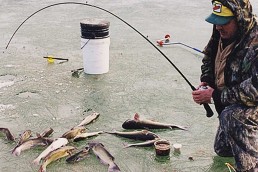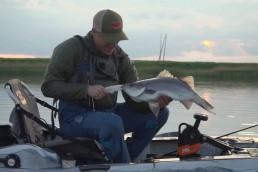Tapping Iced-over Farm Ponds for Winter Catfish
SHARE THIS POST
Fishing on a farm pond in Iowa with temperatures in the 20s with a little sun shining through can make for a great day in the outdoors.
It was early in the afternoon, and we had drilled several holes in the ice with the augers, checked the depth spots, put on the waxworms and sat down on buckets for a bit of ice fishing. This pond was stocked with bluegills, bass, and catfish, although none of the “old whiskers” variety had ever been caught in the past through the ice. After a few bobber bounces from what appeared to be a bluegill, a much more meaningful reaction to fish “tampering” came about as the fishing rig almost went down the hole. One of the anglers was able to get a hold of the pole, and took on what appeared to be a very robust largemouth. And after some skillful playing of the “culprit,” out came the splash and a good-sized fish. But as it got into the hole bored in the ice, that hole seemed to be filled with “whiskers.” And after a time of playing the fish, the man operating the pole lifted out nice-sized channel catfish.
The pond owner was not surprised, as he had stocked them. But this was the first time he had ever caught one while ice fishing. We did not catch very many bluegills that day, but spent several hours “wrassling in” some channel cat in the 2- to 4- pound range. Now, catfish are certainly to be found in a lot of Midwestern farm ponds, and every once in a while they take the waxworm on your rig. After a tussle, and the “cat-on-ice,” the question is: How do you get more?
Since waxworms were what we had for bait that day, and the “cats” seemed to be attracted, we spent several hours continuing to catch mostly catfish that day.
So, if you continue to pull them in with that bait, the ice jig and light test line, by all means keep it up. But it seems that if they are in a pond, they may not keep taking the waxworms, or, the ice jig is not doing the job and the light line on your ice rig won’t hold Mr. Whiskers. So how do you change strategy?
Some possible “switch-a-roos” in approach may be in store. It’s no secret that shad guts work well on catfish during the summer and winter. And to add to the “bait” in this case, why not try using a rubber catfish worm that works with dip bate? It seems that the brighter the worm, the more it may attract catfish to the bait. With the extremely clear water in winter, maybe it does attract fish to the hook. Also, another “helper” may consist of pushing the rubber worm off the treble hook and putting the shad guts on. This may also be a time to use a regular fishing pole with a reel, like a ZEBCO 33, and some 6- or 8-pound-test line. And since the line is heavier, you may need to put on some extra split shot to get the line to just above the bottom. The heavier line and heavier pole makes it easier to set the hook in the hard mouth of the channel cat without breaking off—this may also be a way for more “catfish success.”
Are you enjoying this post?
You can be among the first to get the latest info on where to go, what to use and how to use it!
Another way to make sure you know when the fish is nibbling is to set the rod tip over the hole on a small cardboard box or tackle box, with a little piece of white tape on the rod directly above the hole to make it easier to detect the bite. And when reeling in a fish, try to keep the end of the rod directly above the hole so there will be less rubbing on the edge of the ice. And, for catfish, a long-nosed pair of side-cutters to clip one or both of the spines while bringing in the fish through the hole may be in order.
Now, if you go to a farm pond always expecting to have channel cats biting day in and day out, you may be disappointed on some occasions, as one day might find a lot of “catfish action.” However, the next time to the pond you may not see one single channel cat biting that day, so the regular, lighter rigs used for bluegills and bass may be all you need to “fill your bucket.”
Of course, as in all ice fishing trips, other essential angler equipment can run from crude to state of the art, as far as cutting the ice hole. The old “ice spud” for the hole-drilling can run up to a power auger to do your drilling. And after drilling your hole with the rest of your equipment in place, just moving your rigs from hole to hole or using battery-powered fish finders, you can spot deep-water fish action to help the process.
The aformentioned ideas, along with use of all sorts of tents or warming devices, can lead to enjoyment in all weather.
A few safety items are also a good investment in case you get into some “rotten” or thin ice. A roll of anchor rope, a bucket, or life jacket or other device which can be thrown can also make a good cushion for sitting on while on the ice. Some folks also wear an inflatable life jacket that can come in handy for safety purposes, and provide insulation from the cold.
Another thing to keep in mind when ice fishing farm ponds—especially for channel cats—is that in most cases this fish doesn’t reproduce in many farm ponds, so be aware of what the owner says about taking too many out over a winter fishing period. Be careful now as much as you would about taking them out of a pond in the summer. And, this also applies when taking out too many big bass at any time—a balance must be maintained to keep from having only small bass left for fishing. Keeping a good-sized bluegill population is also important. Know what the owner thinks about keeping the pond lively and productive during any time of year, and fish according to his or her ideas to keep everyone happy.
MWO
SHARE THIS POST
You may also like...
0 CommentsProspecting for Memories on Illinois Farm Ponds
0 CommentsProspecting for Memories on Illinois Farm Ponds
Did you enjoy this post?
You can be among the first to get the latest info on where to go, what to use and how to use it!
Richard Peterson
MidWest Outdoors works with more than 200 outdoor experts each year, who contribute articles based on their areas of expertise. MidWest Outdoors magazine offers more fishing and hunting articles than any other publication!

